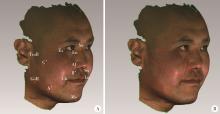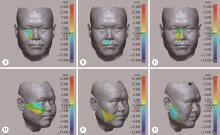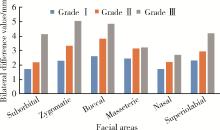Journal of Peking University (Health Sciences) ›› 2023, Vol. 55 ›› Issue (4): 708-715. doi: 10.19723/j.issn.1671-167X.2023.04.023
Previous Articles Next Articles
Category of facial symmetry perception after maxillary reconstruction using anterolateral thigh flap
Ying HUANG,Zhi-yuan WU,Xing-hong ZHOU,Zhi-gang CAI,Jie ZHANG*( )
)
- Department of Oral and Maxillofacial Surgery, Peking University School and Hospital of Stomatology & National Center for Stomatology & National Clinical Research Center for Oral Diseases & National Engineering Research Center of Oral Biomaterials and Digital Medical Devices & Beijing Key Laboratory of Digital Stomatology & NHC Research Center of Engineering and Technology for Computerized Dentistry & NMPA Key Laboratory for Dental Materials, Beijing 100081, China
CLC Number:
- R782.4
| 1 |
Piazza C , Paderno A , Del Bon F , et al. Palato-maxillary reconstruction by the angular branch-based tip of scapula free flap[J]. Eur Arch Otorhinolaryngol, 2017, 274 (2): 939- 945.
doi: 10.1007/s00405-016-4266-0 |
| 2 | 于森, 王洋, 毛驰, 等. 1107例上颌骨缺损的临床分类及修复方法分析[J]. 北京大学学报(医学版), 2015, 47 (3): 509- 513. |
| 3 |
Bianchi B , Ferri A , Ferrari S , et al. The free anterolateral thigh musculocutaneous flap for head and neck reconstruction: One surgeon's experience in 92 cases[J]. Microsurgery, 2012, 32 (2): 87- 95.
doi: 10.1002/micr.20952 |
| 4 | Lavadera P , Schultz J , Sinkin J . Orbital floor and maxillary reconstruction with titanium mesh and anterolateral thigh free flap[J]. Eplasty, 2019, 19 (7): 126- 130. |
| 5 | Eitezaz FA , Rashid M , Yousaf S , et al. Can the anterolateral thigh flap replace the rectus abdominis free flap in the reconstruction of complex maxillary defects?[J]. J Ayub Med Coll Abbottabad, 2018, 30 (1): 74. |
| 6 | 刘志荣, 彭歆, 章文博. 游离腓骨瓣和股前外侧穿支皮瓣修复单侧上颌骨缺损患者的生存质量问卷调查研究[J]. 中华整形外科杂志, 2018, 34 (8): 644- 647. |
| 7 |
Springer IN , Wannicke B , Warnke PH , et al. Facial attractiveness: Visual impact of symmetry increases significantly towards the midline[J]. Ann Plast Surg, 2007, 59 (2): 156- 162.
doi: 10.1097/01.sap.0000252041.66540.ec |
| 8 | Berssenbrugge P , Lingemann-Koch M , Abeler A , et al. Mea-suring facial symmetry: A perception-based approach using 3D shape and color[J]. Biomed Tech (Berl), 2015, 60 (1): 39- 47. |
| 9 |
Philipp MM , Angelika SE , Ute B , et al. Three-dimensional perception of facial asymmetry[J]. Eur J Orthod, 2011, 33 (6): 647- 653.
doi: 10.1093/ejo/cjq146 |
| 10 | Patel A , Islam SM , Murray K , et al. Facial asymmetry assessment in adults using three-dimensional surface imaging[J]. Prog Orthod, 2015, 16 (10): 36- 44. |
| 11 |
Hallac RR , Feng J , Kane AA , et al. Dynamic facial asymmetry in patients with repaired cleft lip using 4D imaging (video stereophotogrammetry)[J]. J Craniomaxillofac Surg, 2017, 45 (1): 8- 12.
doi: 10.1016/j.jcms.2016.11.005 |
| 12 |
Cassi D , Battistoni G , Magnifico M , et al. Three-dimensional evaluation of facial asymmetry in patients with hemifacial microsomia using stereophotogrammetry[J]. J Craniomaxillofac Surg, 2019, 47 (1): 179- 184.
doi: 10.1016/j.jcms.2018.11.011 |
| 13 |
Brown J , Shaw RJ . Reconstruction of the maxilla and midface: Introducing a new classification[J]. Lancet Oncol, 2010, 11 (10): 1001- 1008.
doi: 10.1016/S1470-2045(10)70113-3 |
| 14 | Krzych J , Lach M , Joniec M , et al. The Likert scale is a powerful tool for quality of life assessment among patients after minimally invasive coronary surgery[J]. Kardiochir Torakochirurgia Pol, 2018, 15 (2): 130- 134. |
| 15 |
Naini FB , Donaldson A , Cobourne MT , et al. Assessing the influence of mandibular prominence on perceived attractiveness in the orthognathic patient, clinician, and layperson[J]. Eur J Orthod, 2012, 34 (6): 738- 746.
doi: 10.1093/ejo/cjr098 |
| 16 | 邢亚彬, 马爱霞. 欧洲五维健康量表EQ-5D-3L和EQ-5D-5L中文版比较的实证研究[J]. 上海医药, 2013, 25 (7): 31- 35. |
| 17 | 萧宁, 王勇, 赵一姣. 三维颜面部软组织正中矢状面确定方法的研究进展[J]. 中华口腔医学杂志, 2018, 53 (7): 495- 499. |
| 18 | Verhoeven TJ , Coppen C , Barkhuysen R , et al. Three dimen-sional evaluation of facial asymmetry after mandibular reconstruction: Validation of a new method using stereophotogrammetry[J]. Int J Oral Maxillofac Surg, 2013, 42 (1): 19- 25. |
| 19 | Schoot RA , Hol MLF , Merks JHM , et al. Facial asymmetry in head and neck rhabdomyosarcoma survivors[J]. Pediatr Blood Cancer, 2017, 64 (10): 26508. |
| 20 | 牛百平, 叶湘玉. 对面部畸形忍受程度的测量研究[J]. 中华口腔医学杂志, 1994, 29 (4): 213- 216. |
| 21 | Hohman MH , Kim SW , Heller ES , et al. Determining the threshold for asymmetry detection in facial expressions[J]. Laryngoscope, 2014, 124 (4): 860- 865. |
| 22 | Kim SW , Heller ES , Hohman MH , et al. Detection and percep-tual impact of side-to-side facial movement asymmetry[J]. JAMA Facial Plast Surg, 2013, 15 (6): 411- 416. |
| 23 | Alqattan M , Djordjevic J , Zhurov AI , et al. Comparison between landmark and surface-based three-dimensionalanalyses of facial asymmetry in adults[J]. Eur J Orthod, 2015, 37 (1): 1- 12. |
| 24 | Wang SJ , Zhang WB , Yao YM , et al. Factors Affecting volume change of anterolateral thigh flap in head and neck defect reconstruction[J]. J Oral Maxillofac Surg, 2020, 78 (11): 2090- 2098. |
| 25 | Brown J , Rogers SN , Mcnally DN , et al. A modified classification for the maxillectomy defect[J]. Head Neck, 2000, 22 (1): 17- 26. |
| 26 | 柯杰, 陈华, 林珠. 西安市正常牙合的青少年软组织X线头影测量研究: 计算机辅助测量[J]. 华西口腔医学杂志, 1994, 12 (3): 188- 191. |
| [1] | Yi-fan KANG,Xiao-feng SHAN,Lei ZHANG,Zhi-gang CAI. Postoperative position change of fibular bone after reconstruction of maxillary defect using free fibular flap [J]. Journal of Peking University (Health Sciences), 2020, 52(5): 938-942. |
| [2] | Shun-ji WANG,Wen-bo ZHANG,Yao YU,Xiao-yan XIE,Hong-yu YANG,Xin PENG. Application of computer-assisted design for anterolateral thigh flap in oral and maxillofacial reconstruction [J]. Journal of Peking University(Health Sciences), 2020, 52(1): 119-123. |
| [3] | WANG Zhe, ZHU Liu-ning, ZHOU Lin, YI Biao. Feasibility of integrating 3D photos and cone-beam computed tomography images used to evaluate changes of soft and hard tissue after orthognathic surgery [J]. Journal of Peking University(Health Sciences), 2016, 48(3): 544-549. |
|
||







